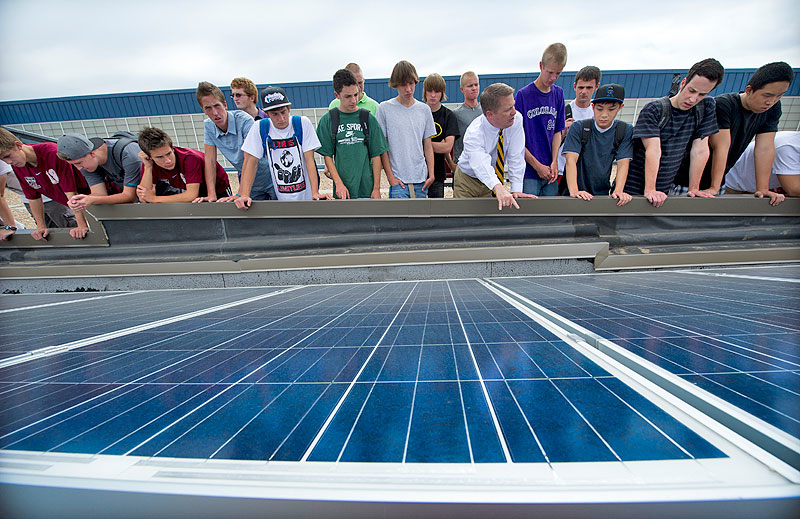
NREL sponsored the “Solar on Schools” program that was adopted by Jeffco Public Schools, the largest district in Colorado. Chatfield High School students learn about photovoltaics on the school’s roof. Credit: Dennis Schroeder
What is Solar Energy?
There are two main types of solar systems in use at schools: (1) Solar Photovoltaic (PV) Systems, which capture solar radiation and convert it directly to electricity1 and (2) Solar Thermal Systems, designed to harness the sun’s heat to provide for water heating or space heating or cooling. Solar energy has been used since the 1950’s and is a stable, clean, and abundant domestic energy source. The US has some of the best solar energyresource potentialin the world 2.
Why ‘Go Solar’?
Public and private K-12 schools are always looking for ways to save money. Solar energy can significantly reduce electricity costs and allow schools to allocate the saved money elsewhere. According to Greentech Media, California schools that have gone solar will save an estimated $1.5 billion in electricity costs over the next 30 years. Solar is a sophisticated and environmentally friendly renewable energy technology that can provide educational opportunities for students in the areas of science, technology, engineering, and mathematics (STEM). Solar has the potential to captivate the imagination of our youth.
Site Criteria
Two key concerns for any school interested in ‘going solar’ are the safety and quality of these energy installations. It is important to ensure that the buildings upon which these systems are installed are up to code and can handle the weight of solar panels. The Environmental Protection Agency (EPA) has a guideon their website that has information about pre-screening a site for solar PV development 3.
Glendale and San Ramon ValleySchoolDistrictshave both gone solar and have posted FAQ’s about their experiences. The City of Philadelphia has posted a Solar Guide Bookthat can assist schools in the process of going solar, and the Sierra Club has developed its Renewable SchoolsOperations Manual,designed to help schools adopt renewable energy or energy efficiency upgrades without cost to school districts or taxpayers. Each state has different regulations and incentives regarding solar installations, so it is important to research the rules, regulations, policies, and incentives that exist in your state 4.
Financing Solar
Some schools choose to own their solar energy systems outright. This guide from the National Renewable Energy Laboratory outlines the different ownership options for schools. The Solar Foundation and the U.S. Department of Energy have produced informational products covering best practices regarding the request for proposal and installation process.
In order to finance these systems, a number of schools have taken the fundraising approach, as seen in the Rochester School District and profiled in the Minnesota Student Energy Project’s Renewable Energy and Schools Guidebook. Due to the comparatively high upfront cost of solar, the federal government encourages solar energy development through the use of tax credits. Unfortunately, non-taxable entities like schools have no tax liability to which they may apply these credits and are therefore unable to take direct advantage of these incentives. Given this, an increasingly common way for a school to go solar is to partner with a solar installation company that will develop, own , and maintain the system in exchange for electricity payments made under a Power Purchase Agreement (PPA). This financing model, however, is only available in states where PPAs have been authorized. Members of the community can also create a third-party entity to own the system on behalf of the school in order to take advantage of tax incentives.
Financing the installation of a solar energy system can be less expensive than anticipated. Many states offer rebates for schools, and some solar companies and utilities (e.g. SolarWorld, Chevron, SolarCity, Pacific Gas and Electric, SunPower, etc.) frequently work with school districts to help reduce or eliminate the upfront costs for solar. School administrators who worry about allowing private companies into their schools can make sure public schools stay commercial-free with this guide from the Institute for Local Self-Reliance.
Solar in the Classroom
Solar is not only a cost-effective energy solution for schools; it can be highly educational. Because solar energy can be used to teach skills that are becoming highly valued in the workplace, it is important for all students to understand the basic principles behind solar energy. Many schools that ‘go solar’ provide students with solar curricula to add educational value to their installations. There are teacher-training workshops as well as free solar energy courses available online 5.
Resources
- Madison Gas and Electric installed solar panels in the Wisconsin area and provided the school with an educational curriculumon renewable energy and real-time performance monitoring for the PV system. Some schools going solar provide online dashboards for LiveSolar Electric Generationmonitoring.
- The National Energy Education Development (NEED) Project has a resource catalogput together by its Teacher Advisory Board.
- Solar School Houseoffers a program on DVD that is classroom-ready and has been reviewed by the Interstate Renewable Energy Council (IREC).
- The Illinois Solar School Programlists teaching guides by grade level.
- DOE Solar Decathlonoffers resources from class lesson plans to at-home activities.
- Solar Schoolsoffers a number of classroom lessons and student-parent activities.
1 http://www.nrel.gov/learning/re_photovoltaics.html
2 http://www.nrel.gov/gis/solar.html
3 http://www.epa.gov/oswercpa/docs/solar_decision_tree.pdf
4 www.gusd.net/cms/lib03/CA01000648/Centricity/Domain/53/Solar%20project%20FAQs%2007-25-2012.pdf; http://patch.com/california/danville/faqs-about-school-district-solar-panels-project; http://www.phila.gov/green/PDFs/PhillySolarGuidebookFinal.pdf; www.lisierraclub.org/; http://www.dsireusa.org/solar/solarpolicyguide/
5 http://www.solarenergy.org/k-12-professional-development; http://www.solarenergy.org/free-online-intro-renewable-energy-course
Resource Guide Prepared By:
The Solar Foundation
505 9th Street NW, Suite 800
Washington, DC 20010
www.TheSolarFoundation.org
Community Power Network
1826 Lamont Street NW
Washington, DC 20004
www.CommunityPowerNetwork.com








Leave a Reply